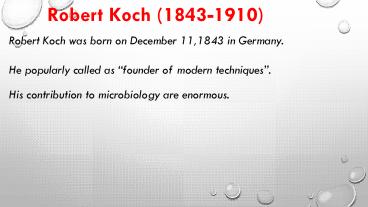Robert koch - PowerPoint PPT Presentation
Title:
Robert koch
Description:
All about Robert koch – PowerPoint PPT presentation
Number of Views:52
Title: Robert koch
1
Robert Koch (1843-1910)
Robert Koch was born on December 11,1843 in
Germany. He popularly called as founder of
modern techniques.
His contribution to microbiology are enormous.
2
In 1876-
Robert Koch have successfully isolated anthrax
bacillus in pure culture, studied formation and
germination of its spores and provided a proof of
its infectiousness. In 1877-
Robert Koch have introduced the method of making
smears of bacteria on glass slides, and of
staining them with anilin dye.
3
In 1878-
He explored the role of animal experimentation in
establishing the cause of bacterial infections.
In 1881-
He described means of cultivating bacteria on
solid media. He also develop pour plate method.
4
In 1882-
He discoveredtubercle bacillus (mycobacterium
tuberculosis), causative agent of tuberculosis,
which was also called as Kochs bacillus. He
described a special staining method for detection
of this microorganism.
In 1883-
He discovered causative agent of cholera(Vibrio
cholaerae), Egyptian ophthalmia (pink eye) and
Kochs weak bacillus.
5
In 1884-
Koch expounded the postulates or laws by which an
organism may be proved to be the cause of
particular disease. These were known as Kochs
postulated.
Kochs postulaates-
- The bacterium should be constantly associated
with lesions of the disease. - It should be possible to isolate the bacterium in
pure culture into suitable laboratory animals
should reproduce lesions to the disecases. - It should be possible to re-isolate the bacterium
in the pure culture from the lesion produced in
experimental animals.
6
He also discovered tubercilin.
In 1885-
He showed how a normal guinea pig and an
already infected guinea pigbehaved differently
To an infection withtubercle bacillus. This is
known as Kochs phenomenon.
In 1890-
Koch studied various Micro-organisms Present in
water, soil, and air and their relation in
prevention of diseases.
7
- Koch invented-
- Hot air oven,
- Steam sterilizer,
- Basic tools in any microbiology laboratory.
- Koch developed-
- Method of testing antiseptics.
- Method to distinguish bacteriostatic and
bactericidal concentration.
8
Thank you































